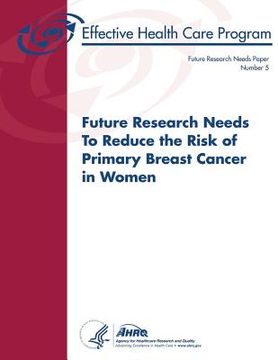Share
Future Research Needs to Reduce the Risk of Primary Breast Cancer in Women: Future Research Needs Paper Number 5 (in English)
U. S. Department of Heal Human Services
(Author)
·
Agency for Healthcare Resea And Quality
(Author)
·
Createspace Independent Publishing Platform
· Paperback
Future Research Needs to Reduce the Risk of Primary Breast Cancer in Women: Future Research Needs Paper Number 5 (in English) - And Quality, Agency for Healthcare Resea ; Human Services, U. S. Department of Heal
$ 17.36
$ 21.99
You save: $ 4.63
Choose the list to add your product or create one New List
✓ Product added successfully to the Wishlist.
Go to My WishlistsIt will be shipped from our warehouse between
Monday, June 24 and
Tuesday, June 25.
You will receive it anywhere in United States between 1 and 3 business days after shipment.
Synopsis "Future Research Needs to Reduce the Risk of Primary Breast Cancer in Women: Future Research Needs Paper Number 5 (in English)"
Breast cancer is the second most commonly diagnosed cancer in women in the United States, with over 200,000 new cases of invasive breast cancer expected in women in 2010. It is the second most common cause of cancer-related death in women, killing over 40,000 women each year. Tamoxifen was approved by the U.S. Food and Drug Administration (FDA) in 1999 as a preventive strategy for women at high risk of developing breast cancer. Data from the 2000 National Health Interview Survey estimated that 10 million U.S. women ages 35 to 79 years of age were candidates for tamoxifen preventive therapy and for 2.4 million of these women, the benefits would outweigh the harms. However, despite its approval for more than a decade, less than one percent of women use tamoxifen as a preventive therapy. In 2007, the FDA approved the use of raloxifene hydrochloride for reduction in the risk of invasive breast cancer in postmenopausal women with osteoporosis and/or at high risk for invasive breast cancer. In 2008, the Agency for Healthcare Research and Quality (AHRQ) commissioned the Oregon Evidence-based Practice Center (Oregon EPC) to conduct a comparative effectiveness review (CER) on the effectiveness of medications to reduce the risk of primary breast cancer in women. Briefly, the five key questions addressed by the review were: (1) In adult women without preexisting breast cancer, what is the comparative effectiveness of selective estrogen receptor modulators (SERMs) tamoxifen and raloxifene, and the selective tissue estrogenic activity regulator (STEAR) tibolone, when used to reduce risk for primary breast cancer on improving short-term and long-term outcomes? (2) What is the evidence for harms? (3) How do outcomes vary by heterogeneity in subpopulations? (4) What is the evidence that harms or secondary potential benefits affect treatment choice, concordance, adherence, and persistence to treatment? (5) What methods, such as clinical risk-assessment models, have been used to identify women who could benefit from medications to reduce risk of breast cancer?

